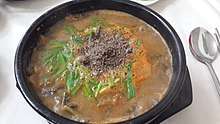Chueo-tang
 Chueo-tang served with perilla seed powder | |
| Alternative names | Loach soup |
|---|---|
| Type | Tang |
| Place of origin | Korea |
| Associated national cuisine | Korean cuisine |
| Main ingredients | Pond loach |
| Korean name | |
| Hangul | 추어탕 |
|---|---|
| Hanja | 鰍魚湯 |
| Revised Romanization | chueo-tang |
| McCune–Reischauer | ch'uŏ-t'ang |
| IPA | [tɕʰu.ʌ.tʰaŋ] |
Chueo-tang (추어탕; 鰍魚湯) or loach soup is a tang (soup) made from pond loach, a freshwater fish.[1][2] The southwestern Korean city of Namwon is famous for its version of the dish.[3][4][5]
Etymology
Chueo (추어; 鰍魚) is a nickname for pond loach, called mikkuraji (미꾸라지) in Korean. Tang (탕; 湯) means soup.
History and tradition
As irrigated rice paddies are drained after chubun (autumnal equinox), chubby pond loaches, ready for hibernation, are easily caught in the ditches dug around paddy fields.[6] Chueo-tang is often a featured dish in banquets for the elderly.[6]
In Hanyang (now Seoul) during the Joseon era, the guild of licensed panhandlers mandated that its members beg only for bap (cooked rice), not banchan (side dishes) or guk (soup).[6] (The practice was intended to maintain dignity and differentiate members from unlicensed beggars.) As an accompaniment to the rice, Panhandlers hunted pond loaches and made chueo-tang. They were also granted the exclusive rights to sell chueo-tang in the city.[6]
Preparation
Pond loaches are boiled in water until very tender, and sieved to remove bones and skins.[7] The sieved flesh along with beef or chicken broth is then boiled again and seasoned with gochujang (chili paste), doenjang (soybean paste), grated ginger, and ground black pepper.[7] Vegetable ingredients include mung bean sprouts, Asian royal fern, scallions, napa cabbages, and mustard greens.[7] The soup is often served with ground chopi peppercorns, along with Korean mint leaves (in Yeongnam region) or perilla powder (in Honam region).[8]
See also
| Wikimedia Commons has media related to Chueotang. |
- Dojō nabe, Japanese pond loach stew
- List of soups
References
- ↑ National Institute of Korean Language (30 July 2014). "주요 한식명(200개) 로마자 표기 및 번역(영, 중, 일) 표준안" (PDF) (in Korean). Retrieved 16 February 2017. Lay summary – National Institute of Korean Language.
- ↑ Jeon, Yuri (19 July 2016). "Top 10 Korean Delicacies to Battle the Heat". 10 Magazine. Retrieved 17 May 2017.
- ↑ Crawford, Matthew (6 January 2017). "Take It Slow In The Historic City Of Namwon". 10 Magazine. Retrieved 17 May 2017.
- ↑ Choi, He-suk (17 July 2013). "Soaking in history and culture along the Jirisan trail". The Korea Herald. Retrieved 17 May 2017.
- ↑ Kim, Rahn (21 May 2015). "'Tasty roads'". The Korea Times. Retrieved 17 May 2017.
- 1 2 3 4 Han, Bok Jin (2005). "Chueo-tang" 추어탕. Uri eumsik baek gaji 1 우리 음식 백가지 1 [One Hundred Essential Korean Dishes Vol. 1] (in Korean). Hyeonamsa. ISBN 89-323-1291-5 – via Naver.
- 1 2 3 "chueo-tang" 추어탕. Doopedia (in Korean). Doosan Corporation. Retrieved 17 May 2017.
- ↑ Hansen, Barbara (28 May 2014). "Chueotang, the Korean Soup That Will Make You Gorgeous, Even If It's Not". LA Weekly. Retrieved 17 May 2017.
_deulkkae_(Perilla_frutescens)_buchu_(Allium_tuberosum).jpg)